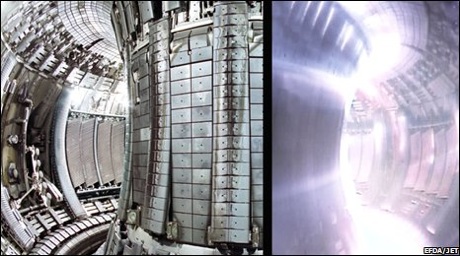 Scientists say an understanding of how the Twin Towers collapsed will help them develop the materials needed to build fusion reactors.
Scientists say an understanding of how the Twin Towers collapsed will help them develop the materials needed to build fusion reactors.
New research shows how steel will fail at high temperatures because of the magnetic properties of the metal.
The New York buildings fell when their steel backbones lost strength in the fires that followed the plane impacts.
Dr Sergei Dudarev told the British Association Science Festival that improved steels were now being sought.
The principal scientist at the United Kingdom Atomic Energy Authority (UKAEA) said one of the first applications for these better performing metals would be in the wall linings of fusion reactors where temperatures would be in a similar range to those experienced in the Twin Towers’ fires.
‘Not melting’
The key advance is the understanding that, at high temperatures, tiny irregularities in a steel’s structure can disrupt its internal magnetic fields, making the rigid metal soft.
“Steels melt at about 1,510C, but lose strength at much lower temperatures,” explained Dr Sergei Dudarev, principal scientist at the United Kingdom Atomic Energy Authority (UKAEA).

Iron atoms in steel: Black balls show irregularities that disrupt magnetic fields, weakening steel
|
At room temperature, the magnetic fields between iron atoms remain regular, but when heated, these fields are altered allowing the atoms to slide past each other, weakening the steel.
“[The steel] becomes very soft. It is not melting but the effect is the same,” said Dr Dudarev.
He said blacksmiths had exploited this property for hundreds of years – it allows iron to become pliable at temperatures much lower than its melting point.
The peak in this pliability is at 911.5C, but begins at much lower temperatures, at around 500C – a temperature often reached during building fires.
The steel backbone of the Twin Towers was probably exposed to temperatures close to this, when insulating panels – meant to protect the buildings’ structural frame – were dislodged by the impacts of the hijacked planes.
The roaring fire mid-way up the building heated the steel struts, and once temperatures rose above 500C the structure became plastic, and collapsed under the force of the floors above.
Tuning up
The interest of Dr Dudarev and the UKAEA is to find steels that can withstand the intense heat of being inside a fusion reactor.
UKAEA has helped pioneer fusion power – deriving energy by forcing together atomic nuclei – at Europe’s JET lab in Oxfordshire; and is now assisting the development work on the world first large-scale experimental reactor known as Iter.
The extended periods over which Iter will run means the reactor must have robust materials built into the vessel where the fusion reactions will occur.
Dr Dudarev said it should be possible to tune the properties of suitable new steels by adding a mix of other elements.
“We need to look at the magnetic properties of steel, [and] vary their chemical composition in a systematic way in order to get rid of this behaviour,” he suggests.
:: Read original here ::